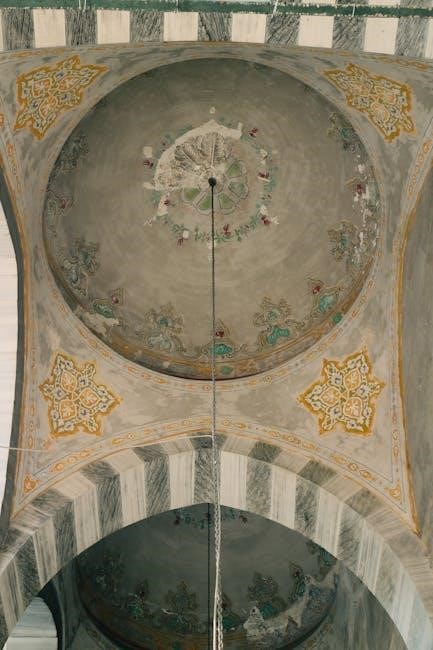Chrismon patterns are Christian symbols used on Christmas trees and in worship spaces, serving as reminders of Jesus’ life and teachings. They are often downloaded as PDF files for crafting and educational purposes, helping to deepen faith and celebrate the true meaning of Christmas.
Definition and Purpose of Chrismons
Chrismons are special Christmas ornaments that symbolize aspects of Jesus’ life, ministry, and teachings. The term “Chrismon” combines “Christ” and “monogram,” reflecting their purpose as visual representations of Christian faith. Typically made from materials like felt, foam, or cardboard, these ornaments are often white with gold trim, beads, or sequins. Their primary function is to remind believers of the true meaning of Christmas—celebrating Jesus’ birth—while also serving as educational tools to teach about Christian symbolism. Chrismons are widely used in churches and homes, adorning trees and worship spaces to inspire reflection and devotion during the holiday season.
Historical Background of Chrismon Ornaments
Chrismon ornaments originated in 1957 at Ascension Lutheran Church in Danville, Virginia, created by Frances Kipps Spencer. The term “Chrismon” is derived from “Christ’s monogram,” reflecting their purpose as symbols of Jesus Christ. These ornaments were designed to emphasize the religious significance of Christmas amid growing commercialization. Early Chrismons were made from simple materials like felt and foam, often adorned with gold trim or beads. They drew inspiration from ancient Christian symbols, such as the Chi-Rho and the fish, which had been used by early followers of Christ. The creation of Chrismons marked a renewed effort to focus on the spiritual meaning of Christmas through visual and educational representations of faith.
Significance of Chrismon Patterns in Christian Celebrations
Chrismon patterns hold profound spiritual significance in Christian celebrations, particularly during Christmas. They serve as visual reminders of Jesus Christ’s life, teachings, and redemptive mission, grounding the festive season in faith. Each symbol, such as the Chi-Rho or the Alpha and Omega, carries biblical meaning, fostering reflection and worship. Churches and homes use these ornaments to create a sacred atmosphere, while their educational value helps teach Christian doctrines to younger generations. By incorporating Chrismons, believers reaffirm the true purpose of Christmas, transforming it from a cultural event into a deeply spiritual observance.
History and Origins of Chrismons
Chrismons originated in 1957 at Ascension Lutheran Church in Virginia, created by Frances Kipps Spencer. The term “Chrismon” combines “Christ” and “monogram,” symbolizing Jesus Christ.
The First Chrismon Ornaments and Their Creator
The first Chrismon ornaments were created in 1957 by Frances Kipps Spencer, a member of Ascension Lutheran Church in Danville, Virginia. Spencer designed these ornaments to symbolize Christ through monograms and Christian symbols, such as the Chi-Rho and the Alpha and Omega. Her vision was to create decorations that would remind worshippers of the true meaning of Christmas. The ornaments were initially handcrafted and used on the church’s Christmas tree, quickly gaining popularity as a way to blend faith and tradition. Today, Spencer is recognized as the founder of the Chrismon tradition, which has spread worldwide.
Evolution of Chrismon Patterns Over the Years
Chrismon patterns have evolved significantly since their inception in 1957. Initially, they were simple, handcrafted symbols like the Chi-Rho and Alpha and Omega. Over time, new designs were introduced, incorporating more intricate details and meanings. Today, Chrismons feature a wide variety of Christian symbols, from traditional crosses to modern interpretations. The materials used have also expanded, with felt, foam, and embroidery being popular choices. Additionally, the rise of digital tools has made it easier to create and share Chrismon patterns, with many PDF designs available online. This evolution has allowed Chrismons to remain relevant, blending tradition with contemporary creativity and accessibility.
Key Figures in the Development of Chrismon Traditions
Frances Kipps Spencer is the founder of Chrismons, creating the first ornaments in 1957 for Ascension Lutheran Church in Virginia. Her designs laid the foundation for this tradition, blending Christian symbolism with artistic craftsmanship. Over the years, other dedicated individuals and church groups have contributed to the evolution of Chrismons, developing new patterns and techniques. These figures have not only preserved the tradition but also expanded its reach, ensuring that Chrismons remain a meaningful part of Christian celebrations. Their efforts have made it possible for people worldwide to access Chrismon patterns through PDF downloads, fostering a sense of community and shared faith.

Common Symbols in Chrismon Patterns
Chrismon patterns feature symbols like the Chi-Rho, Alpha and Omega, anchor, dove, fish, and various crosses, each representing aspects of Christ’s life and teachings, available in downloadable PDF designs.
The Chi-Rho Symbol and Its Meaning
The Chi-Rho symbol, formed by the first two letters of “Christ” in Greek (Χ and Ρ), is a foundational Chrismon pattern. It represents Jesus as the Messiah and is often decorated with intricate gold trim or beads. Originating in early Christianity, the Chi-Rho was popularized by Emperor Constantine, who used it as a military banner. In Chrismon patterns, it signifies Christ’s divine nature and redemption. Available in PDF designs, this symbol is a popular choice for Christmas trees and worship spaces, serving as a visual reminder of Christ’s love and salvation. Its historical and spiritual significance makes it a central element in Christian celebrations and decorations.
The Alpha and Omega as Representations of Christ
The Alpha and Omega symbols, derived from the first and last letters of the Greek alphabet, signify Christ as the beginning and end of all creation. In Chrismon patterns, these symbols are often depicted together, sometimes with a cross or wreath, emphasizing Christ’s eternal nature. Available as PDF downloads, these designs are popular for crafting ornaments that reflect Jesus’ role as the creator and sustainer of life. The Alpha and Omega serve as powerful reminders of God’s plan and Christ’s redemption, making them a meaningful addition to Christian celebrations and worship spaces. Their presence in Chrismon patterns helps deepen the spiritual connection to the true meaning of Christmas.

The Anchor as a Symbol of Hope and Faith
The anchor is a timeless Chrismon symbol representing hope and faith, rooted in Hebrews 6:19, where it signifies a steadfast assurance of God’s promises. Often depicted with ropes, it embodies stability and trust in Christ. In Chrismon patterns, the anchor is typically rendered in white with gold accents, enhancing its spiritual significance. Available as PDF downloads, these designs inspire crafting ornaments that reflect trust in God’s faithfulness. The anchor serves as a reminder of eternal hope and unwavering faith, making it a cherished element in Christian celebrations and worship spaces. Its presence in Chrismon patterns underscores the enduring promise of salvation and divine guidance.
The Dove and Its Significance in Christian Symbolism
The dove is a profound symbol in Christian faith, representing the Holy Spirit, peace, and new beginnings. In Chrismon patterns, the dove often appears as a white ornament with gold accents, symbolizing purity and divine light. It is frequently depicted carrying an olive branch, recalling the story of Noah and the promise of renewal. The dove also signifies the Holy Spirit’s presence, as seen at Jesus’ baptism. Available as PDF downloads, these patterns allow crafting of ornaments that inspire reflection on the Holy Spirit’s role in Christian life. The dove’s presence in Chrismon designs reminds believers of God’s peace and the hope of eternal life, making it a cherished symbol in worship and home décor.
The Fish as an Early Christian Symbol
The fish, known as the Ichthys, is one of the earliest and most enduring Christian symbols. It represents Jesus Christ and was used by early Christians as a secret sign during times of persecution. The Greek word “Ichthys” forms an acronym for “Jesus Christ, Son of God, Savior.” In Chrismon patterns, the fish is often depicted in white and gold, symbolizing purity and divine light. It reminds believers of Christ’s role as the source of spiritual nourishment and salvation. Available as PDF downloads, these patterns allow crafting of ornaments that reflect the fish’s deep symbolic meaning in Christian faith, making it a meaningful addition to worship spaces and home décor.
Cross Variations and Their Spiritual Meanings
Cross variations hold profound spiritual significance in Chrismon patterns, symbolizing Christ’s sacrifice and resurrection. Common designs include the Latin Cross, Celtic Cross, and Jerusalem Cross, each with unique meanings. The Latin Cross emphasizes Christ’s crucifixion, while the Celtic Cross incorporates a circle, representing eternal life. The Jerusalem Cross symbolizes Christianity’s spread worldwide. These crosses are often crafted using white and gold materials, with intricate details that enhance their symbolic depth. Available as PDF downloads, Chrismon cross patterns allow individuals to create ornaments that serve as powerful reminders of faith and redemption, enriching both personal devotion and church decorations with their timeless spiritual messages.

Materials and Crafting Techniques
Traditional Chrismon crafting uses white felt, cardboard, or foam, adorned with gold trim, beads, or sequins. Patterns are traced, cut, and decorated to symbolize faith and joy.
Traditional Materials for Making Chrismons
Traditional Chrismons are crafted using simple, accessible materials such as white felt, cardboard, or foam. These materials are chosen for their durability and ease of use. Gold trim, beads, or sequins are often added to enhance the ornaments’ visual appeal and symbolic meaning. The white base represents purity and light, while gold signifies royalty and divinity, reflecting Christ’s majesty. These materials are widely available, making it easy for individuals or groups to create Chrismons at home or in church settings. The simplicity of the materials ensures that the focus remains on the spiritual significance of the symbols rather than elaborate designs.
Step-by-Step Guide to Crafting Chrismons
Crafting Chrismons begins with selecting a pattern, often downloaded as a PDF from online resources. Trace the design onto white felt, cardboard, or foam using scissors or a craft knife to cut out the shape. Add gold trim, beads, or sequins to highlight details, following the symbolic meaning of each element. For stability, attach a loop of gold string or wire to the top. Many creators use these ornaments to decorate church trees or homes, reinforcing the spiritual connection to Christmas. The process is simple, making it accessible for both individuals and groups to create meaningful, faith-inspired decorations. This hands-on approach fosters reflection on Christ’s life and teachings during the holiday season.
Modern Adaptations and Creative Variations
Modern adaptations of Chrismon patterns have introduced fresh materials and techniques, blending tradition with contemporary creativity. Many crafters now use digital tools to design intricate patterns, which can be downloaded as PDF files for precision cutting. Some incorporate recycled materials or 3D elements, while others experiment with vibrant colors and textures. Personalization has also become popular, with custom symbols or names added to ornaments. Additionally, cultural influences are being infused, creating unique fusions of traditional Christian symbols with global artistic styles. These innovations ensure that Chrismon patterns remain relevant and engaging, inspiring new generations to explore their spiritual significance while embracing creative expression. This evolution keeps the tradition alive and vibrant in modern celebrations.
Cultural and Spiritual Significance
Chrismon patterns hold deep cultural and spiritual meaning, reflecting Christian faith through symbols like the Chi-Rho and Alpha-Omega, while uniting communities in worship and tradition.
Chrismons in Church Decorations and Worship
Chrismons are integral to church decorations, adorning Christmas trees and worship spaces with symbols like the Chi-Rho and Alpha-Omega. These ornaments, often made from white felt with gold trim, serve as visual reminders of Christ’s life and teachings. They are typically displayed during Advent and Christmas seasons, creating a sacred atmosphere that focuses congregations on the true meaning of the holiday. Many churches use Chrismons to enhance liturgical decor, while others incorporate them into educational programs to teach about their symbolic meanings. Their presence in worship spaces fosters a deeper connection to faith and community.
Chrismons as Educational Tools for Christian Teachings
Chrismons serve as powerful educational tools, helping to teach Christian teachings through symbolic representations. They are often used in Sunday schools, youth programs, and Bible studies to explain the meaning of Christmas and the life of Jesus Christ. The symbols, such as the Chi-Rho, Alpha and Omega, and the cross, provide visual aids for understanding key biblical concepts. By crafting and studying Chrismons, individuals, especially children, can deepen their faith and learn about the significance of Christian traditions. These ornaments also encourage discussions about the spiritual meaning of Christmas, making them invaluable resources for religious education and personal reflection.
Chrismons in Home Decor and Personal Devotion
Chrismons are not only used in church settings but also find a special place in home decor, serving as reminders of faith and spirituality. Many Christians incorporate these symbols into their holiday decorations, creating a sacred atmosphere that reflects their beliefs. In personal devotion, Chrismons provide a focal point for prayer and reflection, helping individuals connect with the true meaning of Christmas. Their presence in homes strengthens faith and fosters a deeper understanding of Christian traditions. By displaying Chrismons, families and individuals can share the story of Christ’s life and teachings, making their homes a sanctuary of worship and joy during the festive season.

Chrismon Patterns and Designs
Chrismon patterns offer a variety of symbolic designs, often available as PDF downloads, allowing individuals to craft meaningful ornaments that represent Christ’s life and teachings through intricate details.
Free Printable Chrismon Patterns Available Online
How to Download and Use Chrismon PDF Patterns
Customizing Chrismon Patterns for Personal Use
Customizing Chrismon patterns allows you to personalize your ornaments, making them unique and meaningful. Start with a downloaded PDF template and adjust the design using software or by hand. Choose materials like felt, foam, or paper in various colors to match your theme. Add personal touches such as names, dates, or favorite verses using paint, markers, or embroidery floss. Incorporate beads, sequins, or ribbons for a decorative finish. For a modern twist, experiment with non-traditional shapes or 3D elements. These customizations not only enhance the visual appeal but also deepen the spiritual connection, making each Chrismon a heartfelt expression of faith. Share your designs with others or use them as gifts, spreading the joy of Christian symbolism during celebrations.
Chrismon patterns, especially in PDF formats, offer a meaningful way to celebrate faith through art and tradition. Their enduring appeal lies in their ability to preserve spiritual significance while inspiring creativity and devotion in both personal and communal celebrations.
The Enduring Appeal of Chrismon Patterns
Chrismon patterns continue to captivate Christians worldwide due to their profound spiritual significance and versatility. Their timeless appeal lies in their ability to blend tradition with personal expression, making them a cherished part of Christian celebrations. Available as downloadable PDF files, these patterns offer accessibility and convenience, allowing individuals and communities to craft meaningful ornaments. Whether used in church decorations or home devotions, Chrismons serve as poignant reminders of faith and heritage. Their adaptability to various materials and crafting techniques ensures they remain relevant across generations, fostering a deeper connection to Christ’s teachings and the true essence of Christmas.
Final Thoughts on the Importance of Chrismons in Celebrations
Chrismons hold a profound significance in Christian celebrations, serving as timeless symbols of faith and devotion. Their intricate designs and deeply rooted meanings provide a powerful way to honor Christ during the Christmas season. By incorporating Chrismons into worship and home decor, believers are reminded of the true purpose of Christmas—celebrating the birth of Jesus. These symbols also act as educational tools, teaching both children and adults about the rich history of Christian imagery. As they are shared across generations, Chrismons foster a sense of community and spiritual connection, ensuring their legacy endures. Their presence in celebrations is a beautiful way to keep Christ at the heart of holiday traditions.
